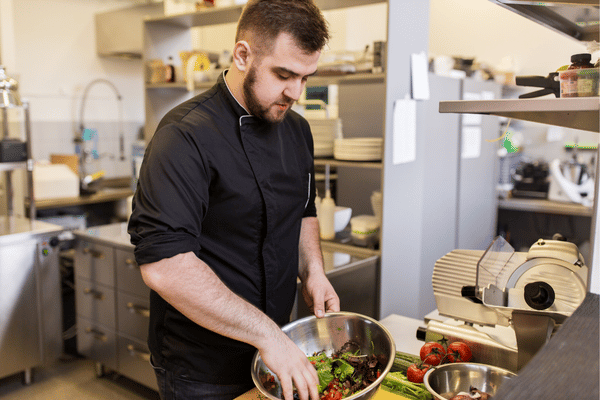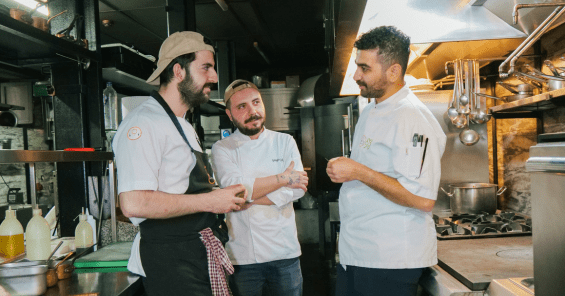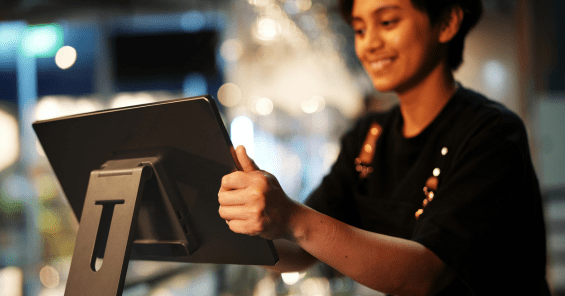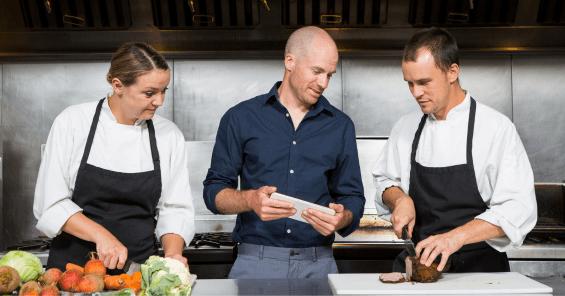

How to Start a Ghost Kitchen
Thinking about opening a ghost kitchen of your own? In this article, we’ll walk you through five things you need to know as well as tips for getting started.
Restaurateurs are learning to adapt to the changing circumstances of a post-COVID world. Even as vaccines rollout, it’s still unclear when – or if – the average restaurant-goer will return to indoor dining with any consistency. And though many restaurants were forced to close down, there is an abundance of talent just waiting to cook, and all they need is a kitchen. Cue the rise of the ghost kitchen.In this article, we’ll walk you through five things you need to know about opening a ghost kitchen of your own.
How To Start And Grow Your Restaurant Business
Whether you're embarking on launching your first restaurant, opening a second (or third) location, or ready to turn your restaurant business into a franchise, this guide will help you make the smartest decisions possible for your business

1) What is a Ghost Kitchen?
A ghost kitchen, otherwise known as a cloud kitchen, dark kitchen, virtual kitchen, or ghost restaurant, is a food-prep and cooking facility solely for food delivery orders. Ghost kitchens are kitchens built exclusively for delivery, and are changing the game for the future of dining. Unlike a traditional restaurant, the customer touchpoints exist online without a brick and mortar location. A customer places an order through the company’s website or a third party delivery app, the food is made in the kitchen, and the meal is delivered to the customer.
Some are branded as a singular entity, like the esteemed Sunset Squares in San Francisco, while others can serve as a hub for multiple complementary eateries, like the newly minted Cloud Kitchens startup. These establishments can run a lean, tight ship and serve the rapidly growing demand for delivery.
Some characteristics of ghost kitchens include: no physical presence, minimal wastage, less risk, and a flexible and adjustable menu.
You may have also heard the phrase virtual restaurant or cloud kitchen: they describe similar things. At their core, they’re spaces devoted to a restaurant or restaurants that are set up exclusively for delivery, without an infrastructure for sit-down service. Ghost kitchens in particular work in conjunction with a brick-and-mortar restaurant, but can either live in the same building as the OG restaurant or use different kitchen locations to expand their reach.
It’s worthwhile to note that a ghost kitchen is different from a virtual restaurant. Virtual restaurants have no brick-and-mortar counterpart and operate exclusively through delivery. Cloud kitchens are locations that multiple virtual restaurants share, sharing costs and equipment but serving different cuisines and customers.
2) What is a Ghost Kitchen’s business model?
A ghost kitchen can exist just about anywhere cooking can be done. The concept can be executed within the kitchen space of a restaurant, or it might be created in an entirely new space rented from a landlord. Some might choose to supply their own equipment, while others might rent kitchen space from a business like Cloud Kitchens.
Here are 6 of the most common ghost kitchen business models:
- Independent model— You operate only one brand.
- Multi-brand model—You run multiple brands within the same kitchen.
- Mid-Ground Model—In addition to delivery, customers can come into your store to order and pick up food.
- Brand-Owned Model—You exclusively partner with one third-party delivery app.
- Hub & Spoke Pod Model—There is one central commissary kitchen and multiple outposts.
- Outsourcing Model—You receive food items from suppliers that are prepackaged.
No matter where the restaurant is located, they’ll enroll their kitchen with many of the popular delivery services like Seamless, DoorDash, and Yelp. If it’s a solo operation, the kitchen will use digital marketing techniques to build and expand their brand, and leverage a combination of social media and traditional word of mouth to reach new customers, in addition to services offered by their chosen delivery apps. If it’s an extension of a pre-existing brand, the ghost kitchen might lean on the audience and marketing channels of the brick-and-mortar restaurant to attract customers.
Related: How To Start a Delivery Service Today and Thrive
3) What are the pros and cons of starting a Ghost Kitchen?
Ghost kitchens are tailor made to take advantage of the delivery boom. By eliminating the overhead associated with table service and foot traffic, they can keep costs related to salaries, space, and the dining experience low or near-zero. They can hone in on branding for digital audiences, while keeping the kitchen lean enough to produce a consistent product.
And, with less to worry about in the front of the house, they can focus on eliminating food waste, managing inventories, and making food production as efficient as possible. Beyond that, ghost restaurants can experiment with new concepts, menus, and offerings with little to no overhead.
However, ghost kitchens are bound to the delivery services in their area, typically within a three to five mile radius of their location. So even though they might not need to pay downtown rent, it might be difficult to serve a hungry downtown customer base. Similarly, ghost kitchens live and die by their third-party integrations. Inefficiencies within delivery platforms, their POS systems, and marketplaces can negatively impact their workflow.
Additionally, without all the window dressing of a sit down restaurant, Ghost Kitchens miss out on additional revenue that could be gained through cocktails, ambience, and so on.
Pros:
- Low overhead costs
- Online branding
- Reactive menus and offerings
- Low startup and real estate costs
- Faster speed to market
- Low infrastructure and overhead costs
- Higher margins
- No dependence on table turnover
- No dependence on foot traffic
- Easy experimentation of menu and concepts
Cons:
- Bound to delivery service
- Reliant on third-party apps and integrations
- Harder to differentiate the brand
- High cost of delivery
- Lower visibility
- No customer data with third-party delivery apps
- Less personal connection with guests
4) How do I know if my restaurant is ready for a ghost kitchen?
Since a ghost kitchen can take on a few different forms, there are a few different ways your restaurant can take advantage of them.
For restaurants with established brands and locations that are looking to take advantage of the delivery boom, a ghost restaurant within your brick-and-mortar kitchen can be an excellent addition to your business with resources you already own. For restaurants that want to house other virtual kitchens like an incubator, a ghost kitchen might occupy some unused or additional space so that it can be leased out to other virtual restaurant brands.
In the first instance, in which the ghost kitchen grows out of your existing restaurant, your business needs a few things:
- Additional space for the ghost kitchen to operate
- Resources, funding, and staffing for the ghost kitchen
- An efficient delivery infrastructure
Bear in mind that a ghost kitchen that operates in the shadow of your main restaurant can offer an excellent opportunity to target customers with delivery options they might not otherwise purchase from your restaurant. Consider how this new class of customers might react to pricing and how their tastes might differ. For example, some customers might be less inclined to order ramen if they have to pour the broth separately.
For the second concept, in which the ghost kitchen operates out of a cloud kitchen or an offsite location, your business needs will differ:
- Startup capital or line of credit for rent and equipment
- Social media presence for marketing
- Access to major delivery partners
Starting a ghost kitchen within an incubator or at a rented location is a business model unto itself. The most important thing to consider is customer acquisition – make sure your food is available on all major delivery apps, discoverable on Google maps, Yelp, and other local sites, as well as social media platforms.
5) What are the ingredients of a successful ghost kitchen?
There are nine key elements to operating a successful ghost kitchen:
1. Choose a concept that resonates with customers
Develop your concept by surveying people in your area to see what type of restaurant and food is popular.
2. Consistent quality food
Quality, and consistency are absolutely crucial to success, as they are in any restaurant. In the game of delivery, even a few bad reviews can hurt your reputation when customers can sort their options in marketplaces by ratings and reviews. Pick menu items that are high quality, travel well, and retain temperature. Choose high-margin menu items so that they offset your delivery costs.
3. Fast delivery
Speed is king in the world of food delivery. 31% of Americans who haven’t tried ordering food online would try it if it were fast. That’s a lot of hungry mouths that could want your food, so long as it gets to their doorstep quickly.
4. Discoverable and accessible
Choose a high-demand area where there are a lot of digital natives and people who prefer delivery. The delivery space isn’t just crowded with restaurants, it’s crowded with marketplaces as well. Everyone has their preference between the big name apps like Seamless, Uber Eats, and GrubHub. And while they’re competing (and sometimes failing) for the attention of the starving masses, your restaurant is competing with hundreds of others on each of them. Discoverability, branding, and marketing are critical to standing out. It’s a lot easier to take a chance on somewhere new if you can see pictures of the menu items. Develop a unique logo, menu, and website that showcases your story.
5. Choose a commercial kitchen
Choose the right commercial kitchen, such as Cloud Kitchens, Kitchen United, Door Dash Kitchens, and Virtual Kitchen Co.
There are many different kinds of kitchens. Some are dedicated to you, while others are shared kitchens. There are different cost structures, like monthly or hourly plans, so choose one that fits your budget and operational hours.
Additionally, make sure you fulfill the commercial kitchen’s requirements: your business registration, Food Handlers, liability insurance, and inspection application.
6. Choose your suppliers and delivery service
You will need to find food distributors and suppliers for your business. You will also need to choose whether you have in-house delivery or partner with one or multiple third-party platforms, such as GrubHub, DoorDash, Postmates, and Uber Eats.
7. Launch your business and iterate
With ghost kitchens, it’s easy to experiment with your concept and menu items. You can use data from MarketMan to figure out what is selling, when it’s selling, and how often. Adjust your prices and ingredients accordingly.
8. Control your inventory
It’s important for you to optimize your food costs. MarketMan can help you control your inventory and jump-start profitability.
9. Do consistent marketing
Since ghost kitchens exist solely online, marketing is very important. Be sure to ramp up your social media and SEO, connect with customers through flyers, events, word of mouth, email, and other tactics, and solicit Yelp reviews.
Related: How to Optimize Your Restaurant’s Website for Near Me Searches
Tips for getting started
Opening a ghost kitchen is no small task. Although you don’t have to deal with any front-of-house headaches as in brick and mortar restaurants, it still requires a lot of coordination to create consistent meals that are delivered in a timely fashion. Follow the guide above, and you’ll be on your way to creating your own ghost kitchen as your next restaurant business.
To ensure your ghost kitchen is working as efficiently as possible, you need a POS system that can integrate with your inventory so you can stay on top of those fast-moving delivery orders. Find out how MarketMan can help you ride the delivery wave today.

Automate your inventory management, control food costs, and streamline back-of-house processes effortlessly with MarketMan's restaurant software. MarketMan enables restaurateurs to eliminate manual tasks, reduce waste, and drive success through strategic insights. Experience a new level of restaurant efficiency. Schedule a demo now to learn how MarketMan can revolutionize your operations!
Author
Contributors
If you have any questions or need help, feel free to reach out
Don't miss out on maximizing your restaurant's profits! Calculate your ROI with MarketMan
Join over 18,000 restaurants and get the hottest restaurant tips delivered to your inbox
You may also be interested in
Ready to get started?
Talk to a restaurant expert today and learn how MarketMan can help your business






